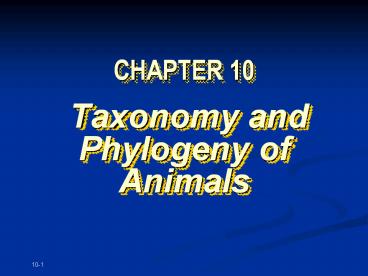Taxonomy%20and%20Phylogeny%20of%20Animals - PowerPoint PPT Presentation
Title:
Taxonomy%20and%20Phylogeny%20of%20Animals
Description:
... (Radiata): phyla Cnidaria Grade II (Bilateria): all other phyla Division A (Protostomia): Mouth is first opening Subdivision of Protostomes by coelom formation: ... – PowerPoint PPT presentation
Number of Views:266
Avg rating:3.0/5.0
Title: Taxonomy%20and%20Phylogeny%20of%20Animals
1
CHAPTER 10
- Taxonomy and Phylogeny of Animals
2
(No Transcript)
3
Linnaeus and Taxonomy
- More than 1.5 million species of animals are
named - Estimated that these account for
- Less than 20 of all animals currently alive
- Less than 1 of extinct animals
- Taxonomy (aka - Systematics)
- Formal system for naming and classifying species
- Science of classifying organisms based on
similarity, biogeography, molecular components,
development, etc.
4
Linnaeus and Taxonomy
- Greek philosopher Aristotle first classified
organisms (350 BC) - Carolus Linnaeus designed the current system of
classification (1750) - Swedish botanist with experience classifying
flowers - Used morphology (study of form and structure) to
develop a classification system of animals and
plants - Divided animal kingdom into species and gave each
a distinctive name - Grouped species into genera, genera into orders,
and orders into classes - His classification scheme has been drastically
altered, but the basic principle is still
followed
5
Carolus Linnaeus
6
Linnaeus and Taxonomy
- Hierarchy of taxonomic ranks now includes 7
major groups - Kingdom, phylum, class, order, family, genus, and
species - Now, the new level of Domain is also used.
- All animals are placed in Kingdom Animalia, or
Domain Eukarya - Taxa (Taxon) - Groups of animals that share a
particular set of characteristics. - Example True Flies Diptera - single pair of
wings - Each rank can be subdivided into additional
levels of taxa - Superclass, suborder, etc.
7
(No Transcript)
8
Division of Life - Milestones
9
3 Domains - current proposal
Based on ribosomal RNA sequences
10
Taxonomy
- Nomenclature assignment of a distinctive name to
each species - A scientific name of an animal consists of two
words (binomial nomenclature) - First word is the genus and is capitalized
- Second is the species written in lower case
- Scientific name should be printed in italics or
underlined if handwritten - Homo sapiens
- Homo sapiens
11
Taxonomy
- Some animals are subspecies, usually caused by
Geographic locations. They are referred to as
trinomials (3 names) - All three terms are in italics
- Subspecies is also in lower case
12
- Ensantina eschscholtzii (salamander) has many
subspecies. - E.e. plantens, E.e. picta, E.e.croceater
13
Taxonomic Characters and Phylogenetic
Reconstruction
- Cladogram
- Diagram illustrating hierarchy of clades (groups
of animals with common ancestry) - Outgroups used
- Phylogenetic tree (compared to cladogram)
- Additional information concerning
- ancestors,
- duration of lineages,
- amount of evolutionary change
- (some mathematical calculation and numerical
values usually invovled)
14
A cladogram
Amphioxus is the outgroup because it doesnt
share any of the defining characteristic with the
other taxa. What characteristic separates Bass
from Horses?
15
Taxonomic Characters and Phylogenetic
Reconstruction
- Sources of Phylogenetic Information
- (What do we use to identify animals in a
Phylogenetic Tree??) - Comparative Morphology
- Examines shapes, sizes and development of
organisms - Skull bones, limb bones, scales, hair and
feathers - Living specimens and fossils are used
16
Taxonomic Characters and Phylogenetic
Reconstruction
- Comparative Biochemistry
- Analyzes sequences of amino acids in proteins and
nucleotides sequences in nucleic acids - Comparative biochemistry can be applied to
fossils - Comparative Cytology
- Examines variation in number, shape and size of
chromosomes - Used almost exclusively on living specimens
17
Phylogenetic Tree based On Cytology Comparing
base substitutions on Cyctochrome C (a
respiratory protein). s represent number of
Mutations that occurred at the ancestral
division.
18
Animal Kingdom Patterns of Organization
Characteristics used to Classify
- Embryonic Tissue Layers
- Diploblastic - 2 tissues (ectoderm and endoderm)
- Triploblastic - 3 tissue layers (also mesoderm)
- Zygote Cleavage
- Protostome - blastopore becomes mouth
- Deuterostome - blastopore becomes anus
- Symmetry
- Asymmetrical (no central body point/axis) ex.
sponge - Bilateral (if divided right/left sides are mirror
image) ex. vertebrates - Radial (any plane cut through organism makes
mirror image) ex. Sea anemone
19
(No Transcript)
20
Major Subdivisions of the Animal Kingdom
- Traditional groupings based on embryological and
anatomical characters - Branch (Parazoa) phylum Porifera,
the sponges and phylum Placozoa - Branch (Eumetazoa) all other phyla
21
Major Subdivisions of the Animal Kingdom
- Branch Eumetazoa
- Grade I (Radiata) phyla Cnidaria
- Grade II (Bilateria) all other phyla
- Division A (Protostomia) Mouth is first opening
- Subdivision of Protostomes by coelom formation
- Acoelomates phyla Platyhelminthes,
- Pseudocoelomates phyla Nematoda,
- Eucoelomates phyla Mollusca, Annelida,
Arthropoda - Division B (Deuterostomia) Anus is first
opening - phyla Echinodermata, Chordata




















